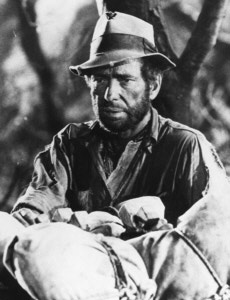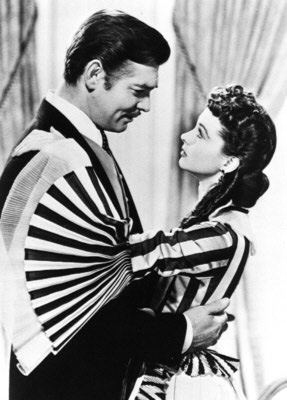The Best Scores of Max Steiner
By JOHN STANLEY
Trying to pick your favorite Max Steiner film scores is like trying asking Noah to pick which of his 900 or so children he liked best. But if I really have to....these are my absolute favorites by Steiner:
"Distant Drums"
(Warner Bros., 1951)
This unusual Western starring Gary Cooper was filmed in the Florida Everglades under Raoul Walsh's direction and depicts the Seminole Indian War of 1840. The music is now considered one of Steiner's most adventurous and exciting scores, even if the film itself follows a pedestrian formula. (Oddly enough, it's a rewrite of the Errol Flynn World War II action film "Objective Burma.")
Steiner opens with an eerie, menacing Seminole theme and segues to a gallant nautical motif for the narrating naval officer played by Richard Webb. Melodic, lush swamp music is used for canoeing through the Everglades, and a heroic fanfare emerges for Cooper's Indian fighter, Quincy Wyatt, symbolized by two hawks that come swooping down to claim the game Quincy has brought for them from the hunt.
Steiner varies this vibrant Wyatt theme in intriguing ways as the troops fight their way through the Everglades, even turning it into a love motif when Cooper moves on the film's only female character, a big-busted woman of dubious background played by Mari Aldon. The crossing of Lake Okeechobee in a longboat borrows water themes first used by Steiner in "Passage to Marseilles." The commando-style raid on a real Spanish fort still standing in the jungle not only gave Walsh a chance to show off his superb action style, but Steiner had opportunities for many Spanish motifs and suspense pieces: the marching sentries, Cooper's climbing of a wall by rope, and the gradual coming together of both sides for the final battle-packed encounter within the fort.
Punchy accompaniment to rousing action was always one of Steiner's fortes, and he brought it to full fruition in the final underwater hand-to-hand battle between Cooper and the Seminole Indian chief who has pursued him throughout the picture. Although you are never in doubt as to the winner, Steiner still helps to keep you on the edge of your seat.
"They Died With Their Boots On"
(Warner Bros., 1941)
This is another successful collaboration between Steiner and director Raoul Walsh. Like "Distant Drums," it stresses heroism and romance but on a more historically grand scale: General Custer and his unit's slaughter at the battle of the Little Big Horn. Steiner liberally borrows the Seventh Cavalry's "Gary Owen" march--a trademark the horse soldiers actually adopted in the 1870s--and uses it to portray the growth of the unit and Custer's acceptance by his troopers.
For the climactic massacre, Steiner created a piercing Indian theme that interrupts the bugle-laden charge whenever the Indians are on the screen. "Gary Owens" or some variation suddenly returns when the troopers are depicted again, and so it goes, the music seesawing back and forth as the two forces eventually come together for the fatal clash. This scoring is considered a tour-de-force by those who have studied film music, and it harkens back to another Steiner classic, "The Charge of the Light Brigade," wherein there was a similar seesaw of themes--heroic theme for the gallant attackers, less glorious, Russian-themed motifs for the enemy troops who are treated as nothing more than villains.
The separation of the loved ones (Flynn as Custer, Olivia de Havilland as his loyal, long-suffering wife) is emphasized by a typically sentimental (though always stirring) love theme, interspersed with bugles playing "Boots and Saddles" and beckoning to Custer, who must soon ride off to his destiny and into the pages of American history.
"The Adventures of Don Juan"
(Warner Bros., 1948)
One of the most beloved of Steiner scores, this rich offering of Spanish themes has a sense of epic grandeur as well as a lighter touch during the amorous misadventures of Errol Flynn as the infamous lover. "Serenade," a violin solo, accompanies most of the kissing sequences, while the "Parade" music, suitable for a coronation, required church bells, guitar, mandolin, harps and baritones--a reflection of the complexity of orchestration that Steiner was permitted at the studio.
Much of the music is syncopated to the action, and takes on comedic touches when a dwarf, a servant to the beautiful queen played by Viveca Lindfors, creeps around the castle in his efforts to help Don Juan and his band of rebels stop a takeover of the throne. In fact, Steiner syncopated each piece of music to the action during the last half-hour, and it is not only brilliant composing but enormously fun to listen to and watch as Flynn swashbuckles through his final great adventure film.
"The Treasure of the Sierra Madre"
(Warner Bros., 1948)

Opening with an ominous orchestration that introduces the "Gold Dust" theme, Steiner suggests at the outset that ironic forces are at work against Fred C. Dobbs (Humphrey Bogart), a down-and-out drifter in Tampico early in the 20th Century. "The Trek" is an uplifting piece that accompanies the the gold-seekers (including Tim Holt and Walter Huston) and emphasizes their growing camaraderie.
Steiner was obviously inspired by John Huston's adaptation of the B. Traven novel, for his score runs a wide, wild range, capturing the cantina spirit of the town, the country's bandits and peasants, and the rugged, arid terrain.
It's really amazing how Steiner could take a musical abstraction and make it fit a real thing. The "Gold Dust" theme actually shimmers and shines and lures and has an undercurrent of danger, which is exactly what the movie is about -- the danger of lust for gold, and how it ultimately tears about three men and pits them in a struggle for survival against nature and their fellow men. And it's all conveyed through that single theme.
"Pursued"
(Warner Bros, 1947)
While most of Steiner's Western scores portrayed the external grandeur of the frontier or the spirit that won the West (as in "San Antonio," "Silver River," "Virginia City" and "Cheyenne"), "Pursued" goes inside the mind of its protagonist and paints sinister, dark shadows that make the stark black-and-white photography. Steiner proves to be a genius at capturing the psychological turmoil of Robert Mitchum's troubled young man, who has been hounded from his adolescence by a blood vendetta. Now considered one of the great "psychological" scores of the "film noir" school, Steiner's music captures the evil, twisted forces symbolized by Dean Jagger, a crippled, sick man who wants only revenge and stops at nothing to get it. There is also an unforgettable theme for the shiny spurs that plague Mitchum in his dreams, a harsh, jolting motif that eventually haunts not only Mitchum but the viewer.
"Gone With the Wind"
(David O. Selznick, 1939)

in 'Gone With the Wind.'
Although nominated for an Oscar, Steiner's music did not win--a fact that today seems a terrible injustice. On the other hand, it was Herbert Stothart's score for "The Wizard of Oz" that did win, and that music has many joyous, memorable moments attached to it. If any film deserved to beat out "Gone With the Wind," that would be the one and only.
Just go back and listen to Steiner's score, however, and you will agree it's a brilliant tour de force.
It came about in the hardest way for Steiner. He had always been producer David O. Selznick's first choice, but Selznick also knew that Max was a perfectionist and would take a long time to write the 3 hours and 15 minutes of music that was needed. So, during the three-month period in which he wrote "Gone with the Wind" (1939), he was under great pressure from producer Selznick to finish. Simultaneously, he was writing the music for an original symphony, and somewhere in all of this he found time to work on the score for Warner's "Four Daughters." Finally, he was forced to ask a doctor to come to his home to give him thyroid extract and vitamin B-12 shots so he could stay awake. His working day was often 18-20 hours. After submitting to a fast four-hour nap, he'd be back on the job.
Steiner kept telling the interfering Selznick he couldn't possibly meet the deadline, so Selznick, toward the end of Steiner's three-month writing spree, purposely leaked a story that he was replacing Steiner with another composer--one who could meet the deadline. Ironically, that composer was Stothart, although Selznick never had any intention of hiring him.
Of course, the story got back to Steiner and he doubled his efforts to finish on time. And did.
Steiner's "Gone With the Wind" soundtrack relied heavily on music of the Civil War era. It features all the tunes that became synonymous with the causes of North and South, as well as many Stephen Foster melodies. There are 16 main themes--of which seven are for specific characters and one for the plantation of Tara, which Steiner considered "a living entity that represented the traditions of the Old South." In all, there were nearly 300 separate musical segments.
"The Caine Mutiny"
(Columbia, 1954)
Steiner wrote many exciting martial themes for war movies ("Fighter Squadron," "Dive Bomber") but topped himself with his Oscar-nominated score for producer Stanley Kramer's adaptation of the Pulitzer Prize-winning novel by Herman Wouk. The opening naval march establishes a complete sense of seafaring duty and love of country, while the "Arrival on the Caine" sets a special motif for the Caine, a rundown mine sweeper that will eventually be a setting for rebellion and mutiny. Steiner repeats this rousing naval motif during the sequence when the Caine, during maneuvers, cuts across its own towline and during the Kwajalein island attack (Steiner, given the larceny in his soul, stole from the Japanese motifs he had first written for "Operation Pacific" three years earlier.)
"I Can't Believe That You're in Love With Me," a song from the 1927 revue "On With the Show," is introduced in a night club sequence, and its melody was adapted for the film's sentimental love theme wherein Robert Francis woos May Wynn.
"Casablanca"
(Warner Bros, 1943)
The opening credits music immediately sweeps the viewer into an exotic mood with its Moroccan theme, which Steiner had lifted almost verbatim from his earlier score for John Ford's "The Lost Patrol" of 1934. This is followed by "La Marseillaise," France's national anthem, which establishes Claude Rains' rule over the city as its chief of police. The anthem comes into play again when German soldiers drinking in Rick's begin to sing "Deutschland uber Alles," Germany's national anthem, and loyal French patriots counter with a vocal rendering to drown out the Germans.
Most famous of all the film's motifs is Steiner's ingenious use of a Herman Hupfeld tune for the 1931 Broadway revue "Everybody's Welcome." That tune was "As Time Goes By," and at first Steiner balked, telling Jack L. Warner he hated the number and felt it was inappropriate to the film. He lost the argument and went on to readapt the tune for the Humphrey Bogart-Ingrid Bergman love affair, giving it an unforgettable poignancy.
And as time goes by, it remains the greatest love-affair motif of all time.
